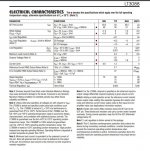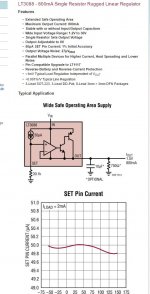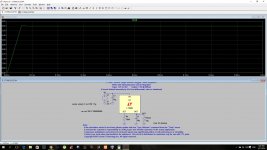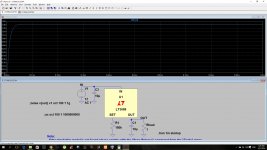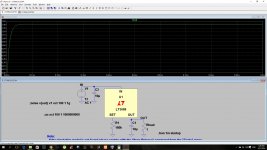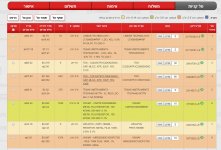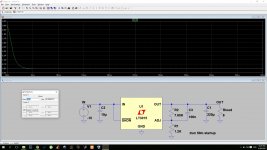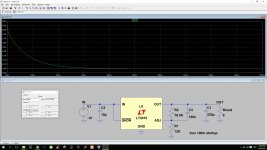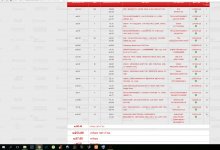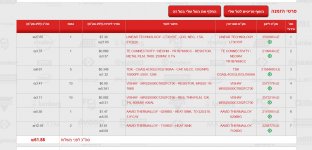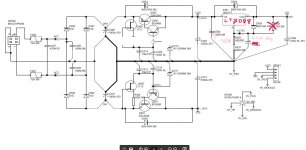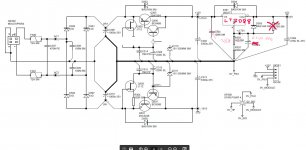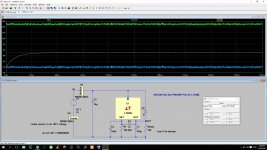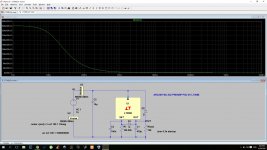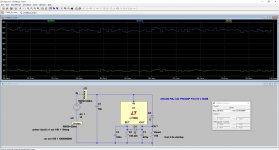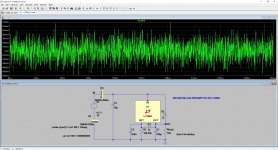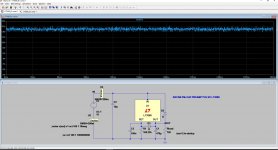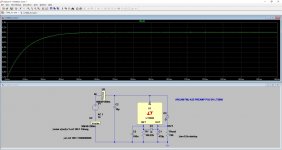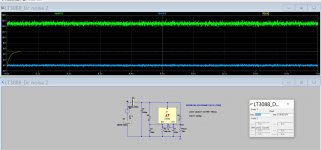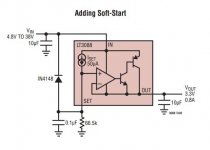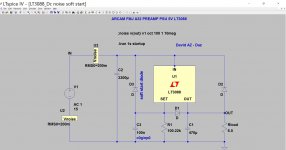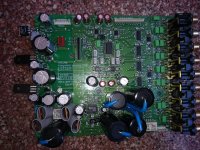LT3088 - 800mA Single Resistor Rugged Linear Regulator
Does anyone here use
New voltage regulators lt3088 from LINEAR TECHNOLOGY
Low noise 27UV
One resistor sets the output voltage
3pin SOT-223
and no expensive 4 $ in farnell
I'll buy a few units
Sounds very good deal
( One thing bothers the Ripple Rejection in 1mhz is 20DB Not the best standard in our day )
Does anyone here use
New voltage regulators lt3088 from LINEAR TECHNOLOGY
Low noise 27UV
One resistor sets the output voltage
3pin SOT-223
and no expensive 4 $ in farnell
I'll buy a few units
Sounds very good deal
( One thing bothers the Ripple Rejection in 1mhz is 20DB Not the best standard in our day )
Attachments
Last edited:
I use the part's cousin in a bunch of projects, the LT3080. There are two "tricks" to keep in mind:
* The tiny "set" pin current results in very large values of "set" resistors, if the output voltage is high (15V in my case). Large value resistors are hard to find in 0.1%. I needed 1.5meg to get 15V out. I wound up splitting it into 1meg and 500K, parts I could get in 0.1%. It looks like LT may have "fixed" that problem to some extent with the 3088 with a set current of 50uA. The 3080 is only 10uA, so with 50uA your resistors are 1/5 the value.
* The parts require a minimum load! I missed that in the data sheet and discovered it the hard way. The part was feeding a switch. With no load the output voltage equals the input voltage, regardless of set resistor. For the LT3080 that mean 12K on the output minimum at 15Vdc. The 3088 datasheet has the requirement even more buried, down in note #3 under the specification table.
* The tiny "set" pin current results in very large values of "set" resistors, if the output voltage is high (15V in my case). Large value resistors are hard to find in 0.1%. I needed 1.5meg to get 15V out. I wound up splitting it into 1meg and 500K, parts I could get in 0.1%. It looks like LT may have "fixed" that problem to some extent with the 3088 with a set current of 50uA. The 3080 is only 10uA, so with 50uA your resistors are 1/5 the value.
* The parts require a minimum load! I missed that in the data sheet and discovered it the hard way. The part was feeding a switch. With no load the output voltage equals the input voltage, regardless of set resistor. For the LT3080 that mean 12K on the output minimum at 15Vdc. The 3088 datasheet has the requirement even more buried, down in note #3 under the specification table.
Last edited:
It's a very neat part. I have used it as well.
For laughs, you can modulate the SET pin and make a cheap amplifier.
For laughs, you can modulate the SET pin and make a cheap amplifier.
definitelyI use the part's cousin in a bunch of projects, the LT3080. There are two "tricks" to keep in mind:
* The tiny "set" pin current results in very large values of "set" resistors, if the output voltage is high (15V in my case). Large value resistors are hard to find in 0.1%. I needed 1.5meg to get 15V out. I wound up splitting it into 1meg and 500K, parts I could get in 0.1%. It looks like LT may have "fixed" that problem to some extent with the 3088 with a set current of 50uA. The 3080 is only 10uA, so with 50uA your resistors are 1/5 the value.
* The parts require a minimum load! I missed that in the data sheet and discovered it the hard way. The part was feeding a switch. With no load the output voltage equals the input voltage, regardless of set resistor. For the LT3080 that mean 12K on the output minimum at 15Vdc. The 3088 datasheet has the requirement even more buried, down in note #3 under the specification table.
I did a simulation in LTSPICE
outpute 9V volt
Rset = 180K
you need minimum of 2 mA on the output - R loud
no loud -no reg
Attachments
Last edited:
I just need find him a partner
Negative voltage
I use the LT3015. I've done a couple of projects now with the LT3015 & LT3080. Both go up to 30V maximum input. In fact, that is how I came to use the 3080 in the first place. I was using a LT3015/LT1963A pair, but the 1963A only goes up to 20V input which is a big problem for 15V out. The LT3080 seemed like the most complimentary thing I could find to the 1963A.
Be sure to include the noise bypass capacitor across the set resistor too with either of these LT regs! It makes a big difference becaue it turns out their noise specification is done at the lowest votlage it can adjust to. Then the noise "gains up" with increasing output voltage. The capacitor helps mitigate that effect. Cff for the 3015 and Cset for the 3080.
Last edited:
jackinnj - interesting! 🙂 I think I've seen a "voltage regulator amplifier" done with a LM317 once too.
I use the LT3015. I've done a couple of projects now with the LT3015 & LT3080. Both go up to 30V maximum input. In fact, that is how I came to use the 3080 in the first place. I was using a LT3015/LT1963A pair, but the 1963A only goes up to 20V input which is a big problem for 15V out. The LT3080 seemed like the most complimentary thing I could find to the 1963A.
Be sure to include the noise bypass capacitor across the set resistor too with either of these LT regs! It makes a big difference becaue it turns out their noise specification is done at the lowest votlage it can adjust to. Then the noise "gains up" with increasing output voltage. The capacitor helps mitigate that effect. Cff for the 3015 and Cset for the 3080.
Thanks
Did you use ceramic capacitors as they say in data sheet ?
I'll buy the whole list and do experiments in building voltage regulators with several different types
LT3088 (I probably use it a constant current lm334 on the outpute of the lt3088 )
TPS7A3301KC
TPS7A4501KTTR
9+
9
8+
8
5+
5
3.3+
It's a shame
I did not find for sale Resistors 160K 0.1%
Only 1%
All resistors small values
I already have
Attachments
Last edited:
I use the LT3015. I've done a couple of projects now with the LT3015 & LT3080. Both go up to 30V maximum input. In fact, that is how I came to use the 3080 in the first place. I was using a LT3015/LT1963A pair, but the 1963A only goes up to 20V input which is a big problem for 15V out. The LT3080 seemed like the most complimentary thing I could find to the 1963A.
Be sure to include the noise bypass capacitor across the set resistor too with either of these LT regs! It makes a big difference becaue it turns out their noise specification is done at the lowest votlage it can adjust to. Then the noise "gains up" with increasing output voltage. The capacitor helps mitigate that effect. Cff for the 3015 and Cset for the 3080.
I must ask you a question?
I ordered the LT3088
And a multitude of components
Especially also ordered C0G capacitors TDK 100NF
60 units
Now I would like to order the LT3015
It will be used to -9V
I must decide on the values of resistors
How low I can go down
I go on
R1 -1.2K
R2-7.65K
I want to go for low values Because that the Cadj
Will 100NF -C0G / NP0
If the value of the resistors R1 will be as they are written in the table 12K
This slows down the start-up time significantly.
I must decide on the resistor values today
because of
I opened a large order in FARNELL
And I did not put the LT3015 yet
Attachments
Last edited:
dazzz - hey I'm sorry about the delayed reply, I hadn't subscribed to this thread. I'm just now circling back to do a post in another thread here and saw your questions.
For the LT3015 (and for the LT3080) I actually use a through-hole film capacitor for the set resistor bypass and a solid polymer organic electrolytic for the output capacitor.
For the bypass capacitor I used a 0.082uF 50V Kemet MMK5823K50J01L16.5TR16 at Mouser, $0.45. I believe my thinking there was that I couldn't get 0.082uF in C0G/NPO ceramic, just X7R, so I went with film. I would be a little hestiant I think with X7R ceramic in this particular application. The capacitance might wind up voltage-modulated a bit. Then again if your rails are 9V and the capacitor is rated at 50V (or 100V) that effect should be minimal, at least with X7R.
You should be OK with 100nF. As I recall I considered that since it was a more common value, but there was some formula in the datasheet and 0.082uF was all I needed. Since I was using film the 0.082uF was a bit smaller I seem to recall than the 0.1uF.
On the output a X7R should work just fine, although I would double whatever they say the minimum is. So if they are suggesting 2.2uF I would go with 4.7uF given that it is X7R. In my case though I used the solid organic polymer electro. They are small and all have low specified ESRs. I used the 22uF 35V 35SEPF22M at Mouser which specifies a 35mR = 0.035 ohm ESR, for $1.05. Those solid organic polymer caps have huge leakage current, so they wouldn't be the best for battery powered. A smaller X7R ceramic would probably be better. My gizmo is AC powered so it didn't matter.
For R1 (adjust to ground) I'm using 2.55K and for R2 24.9K in series with 30.1 ohms. I put the 30.1R in there as a fine-adjustment resistor.
I have the full schematic, BOM, and other project materials for that project posted at Google Drive here:
https://drive.google.com/folderview?id=0B67cJELZW-i8Yk1EVzEyb2swblE&usp=sharing
The power supply section is at the top of the schematic. That project has both the LT3015 and LT3080. Most of the part numbers are on the schematic, but the BOM has the full list.
You are right about the set resistor bypass capacitors, they do cause a startup delay! Defnitely has to be taken into account for your project. For my project is doesn't matter because there is a headphone relay on the output with a 3 second delay for this very reason. It doesn't matter if the two power rails don't exactly track on startup, the headphones are not connected until everything is stable. Your 1.2K and 7.65K should be OK. As I recall there was a minimum load issue with the LT3015 and my values were meeting the minimum load. Since your values are even smaller you should be fine.
For the LT3015 (and for the LT3080) I actually use a through-hole film capacitor for the set resistor bypass and a solid polymer organic electrolytic for the output capacitor.
For the bypass capacitor I used a 0.082uF 50V Kemet MMK5823K50J01L16.5TR16 at Mouser, $0.45. I believe my thinking there was that I couldn't get 0.082uF in C0G/NPO ceramic, just X7R, so I went with film. I would be a little hestiant I think with X7R ceramic in this particular application. The capacitance might wind up voltage-modulated a bit. Then again if your rails are 9V and the capacitor is rated at 50V (or 100V) that effect should be minimal, at least with X7R.
You should be OK with 100nF. As I recall I considered that since it was a more common value, but there was some formula in the datasheet and 0.082uF was all I needed. Since I was using film the 0.082uF was a bit smaller I seem to recall than the 0.1uF.
On the output a X7R should work just fine, although I would double whatever they say the minimum is. So if they are suggesting 2.2uF I would go with 4.7uF given that it is X7R. In my case though I used the solid organic polymer electro. They are small and all have low specified ESRs. I used the 22uF 35V 35SEPF22M at Mouser which specifies a 35mR = 0.035 ohm ESR, for $1.05. Those solid organic polymer caps have huge leakage current, so they wouldn't be the best for battery powered. A smaller X7R ceramic would probably be better. My gizmo is AC powered so it didn't matter.
For R1 (adjust to ground) I'm using 2.55K and for R2 24.9K in series with 30.1 ohms. I put the 30.1R in there as a fine-adjustment resistor.
I have the full schematic, BOM, and other project materials for that project posted at Google Drive here:
https://drive.google.com/folderview?id=0B67cJELZW-i8Yk1EVzEyb2swblE&usp=sharing
The power supply section is at the top of the schematic. That project has both the LT3015 and LT3080. Most of the part numbers are on the schematic, but the BOM has the full list.
You are right about the set resistor bypass capacitors, they do cause a startup delay! Defnitely has to be taken into account for your project. For my project is doesn't matter because there is a headphone relay on the output with a 3 second delay for this very reason. It doesn't matter if the two power rails don't exactly track on startup, the headphones are not connected until everything is stable. Your 1.2K and 7.65K should be OK. As I recall there was a minimum load issue with the LT3015 and my values were meeting the minimum load. Since your values are even smaller you should be fine.
Last edited:
LT3091
dazzz - also I forgot about jackinnj's post here about the new negative LT3091
http://www.diyaudio.com/forums/powe...ear-announces-negative-complement-lt3080.html
I just spotted that post a couple of days ago. I'm on the mailing list for new LT parts but I missed that one somehow. It is in stock and shipping at Digikey:
LT3091IT7#PBF Linear Technology | Integrated Circuits (ICs) | DigiKey
The part looks like a compliment to the LT3080 since it is 1.5A, uses a set current rather than voltage, can be paralleled, and is available in TO-220. But on close read it is like just about anything else at Linear Technology, they are not really big on exact compliments. 🙄 Their complimentary parts are always "sort of" complimentary it seems.
In my case I've decided to stay with the LT3015. The 3015 costs $1 less, does what I need, I don't have to deal with 2 extra pins I won't be using (no need for a current monitor) and the noise specification doesn't seem to be all that much better, especially when you take the "set" resistor Johnson noise into account. But I may be missing something too with that part. I haven't spent a whole lot of time with the sheet.
dazzz - also I forgot about jackinnj's post here about the new negative LT3091
http://www.diyaudio.com/forums/powe...ear-announces-negative-complement-lt3080.html
I just spotted that post a couple of days ago. I'm on the mailing list for new LT parts but I missed that one somehow. It is in stock and shipping at Digikey:
LT3091IT7#PBF Linear Technology | Integrated Circuits (ICs) | DigiKey
The part looks like a compliment to the LT3080 since it is 1.5A, uses a set current rather than voltage, can be paralleled, and is available in TO-220. But on close read it is like just about anything else at Linear Technology, they are not really big on exact compliments. 🙄 Their complimentary parts are always "sort of" complimentary it seems.
In my case I've decided to stay with the LT3015. The 3015 costs $1 less, does what I need, I don't have to deal with 2 extra pins I won't be using (no need for a current monitor) and the noise specification doesn't seem to be all that much better, especially when you take the "set" resistor Johnson noise into account. But I may be missing something too with that part. I haven't spent a whole lot of time with the sheet.
Last edited:
dazzz - also I forgot about jackinnj's post here about the new negative LT3091
http://www.diyaudio.com/forums/powe...ear-announces-negative-complement-lt3080.html
I just spotted that post a couple of days ago. I'm on the mailing list for new LT parts but I missed that one somehow. It is in stock and shipping at Digikey:
LT3091IT7#PBF Linear Technology | Integrated Circuits (ICs) | DigiKey
The part looks like a compliment to the LT3080 since it is 1.5A, uses a set current rather than voltage, can be paralleled, and is available in TO-220. But on close read it is like just about anything else at Linear Technology, they are not really big on exact compliments. 🙄 Their complimentary parts are always "sort of" complimentary it seems.
In my case I've decided to stay with the LT3015. The 3015 costs $1 less, does what I need, I don't have to deal with 2 extra pins I won't be using (no need for a current monitor) and the noise specification doesn't seem to be all that much better, especially when you take the "set" resistor Johnson noise into account. But I may be missing something too with that part. I haven't spent a whole lot of time with the sheet.
Thanks for the reply bro
Yesterday I made a order on the LT3015
I almost ordered the LT3091
But it requires a little more components
The LT3015 will be an excellent partner for LT3088
I also ordered a good heat sink
to Match the
T0-220
TO-263
Attachments
I'm going to use LT3088
As a substitute for LM317
In the psu Preamp project on the ARCAM FMJ32
I only hope that will be enough 800ma
Since the LM317 is 1.5A
As a substitute for LM317
In the psu Preamp project on the ARCAM FMJ32
I only hope that will be enough 800ma
Since the LM317 is 1.5A
Attachments
Last edited:
LTSPICE NOISE TEST FOR THE ARCAM 5V REG LT3088
INPUT 15V 400mv ripple noise
INPUT 15V 400mv ripple noise
Attachments
Last edited:
I only hope that will be enough 800ma
Since the LM317 is 1.5A
If you have the space two of those 3088's can be paralleled for more current. The 3080 is the same way, allows several in parallel for more current or power dissipation spreading.
agdr what you ThinkIf you have the space two of those 3088's can be paralleled for more current. The 3080 is the same way, allows several in parallel for more current or power dissipation spreading.
This idea to add soft start diode ?
Attachments
Last edited:
The capacitor is for soft start.agdr what you Think
This idea to add soft start diode ?
The diode discharges the capacitor safely if the input is shorted
I use the part's cousin in a bunch of projects, the LT3080. There are two "tricks" to keep in mind:
* The tiny "set" pin current results in very large values of "set" resistors, if the output voltage is high (15V in my case). Large value resistors are hard to find in 0.1%. I needed 1.5meg to get 15V out. I wound up splitting it into 1meg and 500K, parts I could get in 0.1%. It looks like LT may have "fixed" that problem to some extent with the 3088 with a set current of 50uA. The 3080 is only 10uA, so with 50uA your resistors are 1/5 the value.
* The parts require a minimum load! I missed that in the data sheet and discovered it the hard way. The part was feeding a switch. With no load the output voltage equals the input voltage, regardless of set resistor. For the LT3080 that mean 12K on the output minimum at 15Vdc. The 3088 datasheet has the requirement even more buried, down in note #3 under the specification table.
minimum load
First experience with the LT3088
Such was not successful
I replaced the preamp my project ARCAME FMJ32
The regulator provides a voltage of 5 V
Digital volume
And display.
(I changed the LM317)
The resistor in ADJ switched to 100K
the cap in Cadj switched film capacitors 100NF vishay 1837
Output voltage 4.93 V
But as soon as I turn the volume knob voltage falls to 3 volt
So a tip to keep minimal Output load would be helpful
for naw I returned to the familiar LM317
Attachments
Last edited:
When ordering LTC parts, sometimes it's better to go through the company's webstore as availability and prices can be better for small lots.
- Status
- Not open for further replies.
- Home
- Design & Build
- Parts
- LT3088
